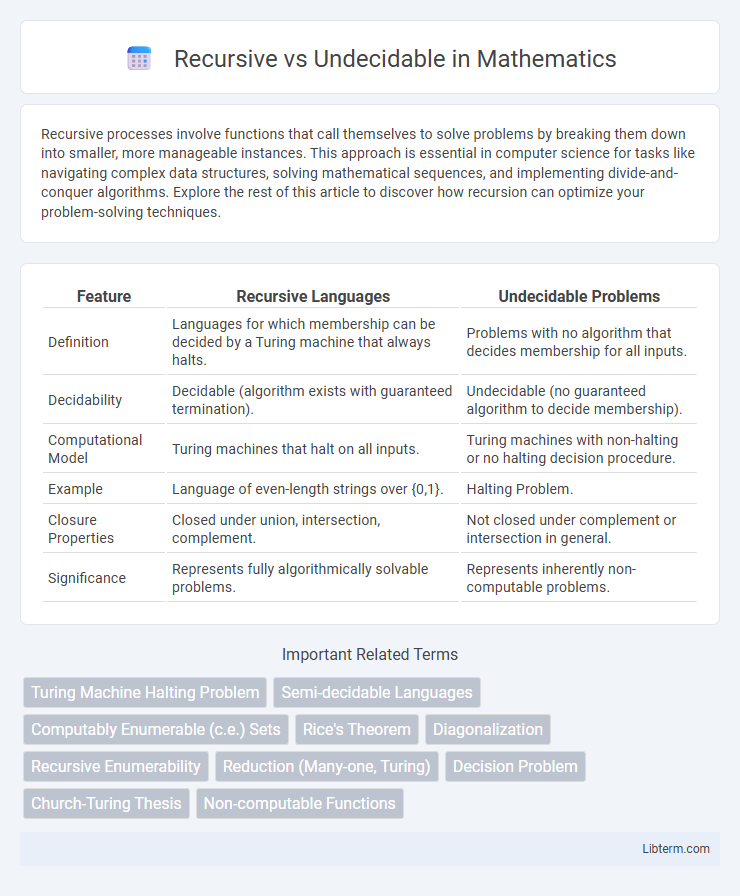Recursive processes involve functions that call themselves to solve problems by breaking them down into smaller, more manageable instances. This approach is essential in computer science for tasks like navigating complex data structures, solving mathematical sequences, and implementing divide-and-conquer algorithms. Explore the rest of this article to discover how recursion can optimize your problem-solving techniques.
Table of Comparison
| Feature | Recursive Languages | Undecidable Problems |
|---|---|---|
| Definition | Languages for which membership can be decided by a Turing machine that always halts. | Problems with no algorithm that decides membership for all inputs. |
| Decidability | Decidable (algorithm exists with guaranteed termination). | Undecidable (no guaranteed algorithm to decide membership). |
| Computational Model | Turing machines that halt on all inputs. | Turing machines with non-halting or no halting decision procedure. |
| Example | Language of even-length strings over {0,1}. | Halting Problem. |
| Closure Properties | Closed under union, intersection, complement. | Not closed under complement or intersection in general. |
| Significance | Represents fully algorithmically solvable problems. | Represents inherently non-computable problems. |
Introduction to Recursive and Undecidable Problems
Recursive problems are those for which a definitive algorithm exists that can determine membership in a language within finite time, exemplified by decidable decision problems. Undecidable problems cannot be resolved by any algorithm; no Turing machine can decide such problems for all possible inputs, with the Halting Problem as a canonical example. Understanding the distinction highlights fundamental limits of computability and is central to theoretical computer science and algorithm theory.
Defining Recursive Languages
Recursive languages are formally defined as those for which a Turing machine exists that halts and accepts every string in the language, and halts and rejects every string not in the language, ensuring decidability. In contrast, undecidable languages lack any such Turing machine that can always halt with a decision for every input, reflecting the limits of algorithmic solvability. The classification of recursive languages emphasizes their computability and the ability to effectively determine membership, distinguishing them clearly from undecidable problems.
Understanding Undecidable Languages
Undecidable languages are those for which no algorithm can determine membership for all possible inputs, meaning there is no Turing machine that always halts with a correct yes-or-no answer. Recursive languages, in contrast, have corresponding Turing machines that always halt and decide membership effectively. Understanding undecidable languages involves recognizing problems like the Halting Problem, which exemplify the limits of algorithmic computation and the boundaries of decidability in formal language theory.
Key Differences: Recursive vs Undecidable
Recursive problems have algorithms that guarantee a yes or no answer for every input, ensuring decidability within finite time. Undecidable problems lack such algorithms, meaning no computational procedure can conclusively determine an answer for all cases. The key difference lies in algorithmic solvability: recursive problems are decidable by Turing machines, whereas undecidable problems exceed the capabilities of any algorithmic method.
Real-World Examples of Recursive Problems
Recursive problems, such as sorting algorithms like mergesort and quicksort, have clear procedures that terminate and produce solutions for any input. In contrast, undecidable problems, exemplified by the Halting Problem, lack any algorithmic solution that guarantees termination for all cases. Real-world applications rely heavily on recursive algorithms for tasks like data processing, while undecidable problems highlight fundamental limits in computation theory.
Famous Undecidable Problems in Computation
Famous undecidable problems in computation include the Halting Problem, which determines whether a given program halts or runs indefinitely, and the Post Correspondence Problem, which involves matching string sequences. Recursive problems are those for which an algorithm can always decide membership, contrasting with undecidable problems that lack any algorithmic solution. These distinctions highlight fundamental limits in computation theory and the boundary between solvable and unsolvable problems.
The Role of Turing Machines
Turing machines play a critical role in distinguishing recursive from undecidable problems by providing a framework to analyze algorithmic solvability and computability. Recursive problems correspond to languages that a Turing machine can decide, halting with an accept or reject state for every input. Undecidable problems describe languages for which no Turing machine can guarantee a decision for all inputs, highlighting the limits of mechanized computation.
Implications for Algorithm Design
Recursive problems guarantee an algorithmic solution that always halts with a correct yes/no answer, providing a foundation for constructing reliable and predictable algorithms. Undecidable problems lack any algorithm that can universally determine membership for all inputs, posing intrinsic limits on automation and demanding heuristic or approximate approaches in algorithm design. Recognizing the boundary between recursive and undecidable problems is essential for designing algorithms that wisely allocate computational resources and set realistic expectations for problem solvability.
Limitations of Computability
Recursive languages represent problems for which algorithms exist that always halt and decide membership, ensuring effective computability. Undecidable problems, such as the Halting Problem, inherently lack any algorithm that can provide a definitive yes-or-no answer for all inputs, demonstrating fundamental limits of computability. These limitations underscore the boundary where algorithmic methods fail, highlighting intrinsic constraints in formal systems and computational models.
Conclusion: Navigating the Boundaries of Computation
Recursive problems are those for which algorithms exist that guarantee a definitive yes or no answer within a finite amount of time, representing the core of computable functions in computer science. Undecidable problems, on the other hand, lack such algorithms, meaning no general method can determine a solution in all cases, highlighting inherent computational limits. Understanding this boundary is crucial for fields like algorithm design, cryptography, and formal verification, where recognizing computability constraints guides effective problem-solving strategies.
Recursive Infographic

 libterm.com
libterm.com